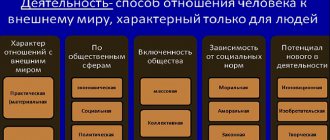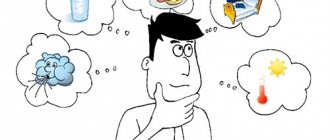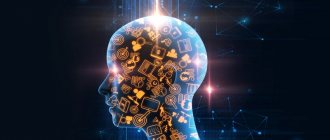Man is an active being. Actually, purposeful activity distinguishes a person from an animal. More precisely, animals also carry out certain types of activities, but most of them are unconscious and are aimed at satisfying the most basic individual needs.
Human activity is connected with his social essence. Indeed, many of the actions of modern man are aimed at maintaining a certain state of society, its development and improvement, and not at satisfying one’s physiological needs. Most of the population of developed countries devotes their lives to activities in such areas as science, art, social activities, entertainment and games, and communication. On the other hand, in many developing countries, “lower-level” activities prevail: obtaining food, ensuring personal safety, etc. The social component in such activities is not so important, so any social norms may not be observed: crime, wild morals and orders, extreme individualism, a distant and suspicious attitude towards others. It follows from this that various types of human activity were formed in the process of its evolutionary and socio-historical development.
Indeed, there was a time when many professions and occupations characteristic of modern society did not exist at all. Only relatively recently (by historical standards), for example, scientists emerged from the entire mass of people - figures who professionally study the world around us and how to influence it. Even later, theoretical and practical science and various scientific disciplines separated: thus, the early ancient Greek philosophers were involved in literally everything - geometry, medicine, and astronomy, they talked about the nature of the universe and invented mechanisms. The gradual complication of scientific knowledge led to a peculiar division of intellectual labor.
What is an activity
Activity
as the process of active interaction between a subject and an object of reality, in which the subject purposefully influences the object, achieving a goal and satisfying his needs.
Activities can be either constructive or destructive. Often both components are present, since often in order to create something, you need to destroy something first, and vice versa (for example, create a weapon to destroy the enemy army). The activity of a person or organization can be called any activity that is given a certain meaning - that is, the activity is somehow connected with the external world or the internal state of a person or organization.
Self-test questions
- Remember the four main types of activities and reveal the meaning of each of them.
- Who can be the subject of the activity?
Vaska the cat.
- Chemistry teacher.
- Students of class 5A of secondary school No. 151.
- Population of the DPRK.
Forms of activity
1.Labor
Labor is a type of activity that is aimed at creating material and spiritual products to satisfy certain needs of man and society.
Characteristic features of labor as a type of activity
- Feasibility (necessity, necessity)
- Having goals aimed at achieving a certain result.
- Availability of knowledge, skills, abilities that allow you to perform certain actions.
- Utility (that is, the results of the activity must actually satisfy needs)
- Personal development (work transforms the person himself, forms the moral qualities of the individual)
- Focus on results and getting them.
- Transformation of the world, society and man himself.
Types of labor
- Physical – characterized by the fact that there is a load on the human body, on its musculoskeletal system.
Physical labor can be: manual, mechanized, assembly line labor, or automated.
- Mental – associated with processing, assimilation of information, requires attention, memory, and activation of thinking processes.
- Mixed – work that requires a combination of both physical and mental effort.
- A game
A game is a type of non-productive activity for which the process itself is important, not the result.
Play for a child is one of the ways to understand the world; A game for adults is both relaxation and entertainment, and at the same time, business games help model the type of behavior in a given situation, for example, when applying for a job.
Read also: How to make bone meal in Minecraft
Characteristic features of the game as an activity
- Conditional situation
- The presence of certain rules for a particular game
- The use of objects that replace real ones (for example, for a child, a doll is her daughter)
- Peculiar goals (satisfying the need for rest, communication, developing certain business conversation skills, etc.)
- The game contributes to the development of moral qualities of the individual, the formation of certain skills and abilities.
- Teaching (study)
Learning is a type of activity as a result of which a person learns about the world, society, himself, and acquires the knowledge, skills, and abilities that he needs for successful life.
Types of teaching
- Organized (it is carried out in educational institutions: school, university, etc.)
- Unorganized (it is carried out as a by-product of the main activity)
- Self-education (a person’s independent acquisition of knowledge and teachings, which is based on personal interest).
Characteristic features of teaching as a type of activity
- Contributes to the development of personality, the formation of his worldview.
- The teaching is based on mastering the experience of previous generations.
- Forms professional knowledge and skills that allow you to successfully perform activities.
- Promotes the assimilation of values and norms of national and world culture.
Human activity has features:
Read also: How to make a sawmill in Terraria?
- Purposeful, conscious in nature, that is, it always has a goal and is aimed at achieving results.
- The planned nature of the activity, that is, it also represents a certain structure.
- Systematicity, that is, activity, is a long, daily process.
- Productivity is the focus of activity on obtaining results.
- Transformative in nature - the activity changes the world around us, society and people.
- Social character, that is, activity is the result of centuries of human labor, it is a product of history.
It should be noted that the activity can be creative in nature.
Levels of need
(
)
A human need is a specific need that an individual satisfies in the course of conscious activity. All needs can be divided into those dictated by physiological and psychological goals, as well as those formed by society.
Hierarchy of levels of needs according to A. Maslow:
- Physiological - based on desires necessary for human survival. These include: thirst, hunger, reproduction. Otherwise they are called natural needs, that is, based on human nature.
- Existential – the need for safety, comfortable living conditions, stability and order.
- Human social needs are dictated by society and are based on the desire to have affection, communicate, and participate in joint activities with others.
- Prestigious - based on the need for recognition, respect from others and self-esteem.
- Human spiritual needs are the desire for self-realization and potential.
The indicated levels of needs according to Maslow are universal.
The basis of human natural needs is interest; it represents a state of motivation that stimulates the beginning of vigorous activity. Interests are usually divided into individual and group. When clarifying whether we need all the needs, we note that they are being implemented consistently. Speaking about what social needs are, this is a secondary interest of the individual if physiological desires are satisfied.
Distinctive features of activity
The activity is characterized by the following distinctive features:
- Consciousness, that is, conscious goal setting.
- Productivity, that is, focus on obtaining results.
- Transformative character, that is, in the process of activity a person transforms the world around him and himself.
- Social character - the need to communicate with other people to achieve results.
Main spheres of society's life
Any type of human activity (work, play, communication, etc.) can take place in any area.
There are traditionally four such areas:
:
- Social
– peoples, classes, gender and age groups, etc. - Economic
– production relations, productive forces. - Political
– the state, parties, socio-political organizations. - Spiritual
- religion, morality, education, art, science.
In this case, each person is affected simultaneously by all four spheres. Each of us belongs to a certain nation, social class, has a certain age and gender, enters into economic relations, has a certain level of education and a certain worldview.
However, not all types of human activity in each of the spheres are equivalent. Thus, in the spiritual sphere, science occupies a dominant position, its “reflections” are education and art; morality depends on the level of collective awareness of society, and religion is a consequence of an extremely low level of this same awareness. The nature of social activity can change over time: in one era the average person can work for the prosperity of his nation, in another his work can be aimed at meeting the needs of all humanity as a whole, because there is no division into peoples and nations.
Types of human activities
All types are divided according to the method of implementation into material (practical) and spiritual.
- The practical form includes the transformation of the material, material world (nature and society). For example, the production of goods or construction. Practical activities are divided into: Material and production - the object is nature, and the result is material goods.
- Socially transformative - the object is society, and the result is a change in social relations.
Its subspecies include:
- Cognitive activity, the result of which is knowledge.
Value-oriented, as a result of which a person’s worldview is formed.
These types are interconnected (practical and spiritual).
For example, the results of spiritual activity (music, scientific achievements) are captured using a practical form (printing notes, publishing books). Well, the practical form, in turn, is impossible without the spiritual (idea).
Another classification of activities is based on the ways of forming a person as an individual. Psychologists have identified several types of activities.
- Gaming – the leading activity in children, there is no goal as such (the process itself is important), is a way of understanding the world. In the game, through imitation of reality, knowledge of the environment is carried out. It is conditional in nature (imaginary situations are played out), but certain rules and norms are followed.
This is the only type of activity that is characteristic not only of people, but also of animals. - Academic – acquiring skills and discovering abilities that will help you live a happier, more comfortable and successful life. Studying may not always be purposeful. Often a person acquires knowledge spontaneously (from TV, movies, books, the Internet). The student does not create new knowledge, but only masters existing knowledge.
- Labor is the interaction of a person with the outside world, aimed at creating a socially useful product (material and spiritual) that helps improve the standard of living of society.
The components of labor are the knowledge and skills of a person, as well as his skill. Work is carried out out of necessity, but at the same time transforms the world around us. It is aimed at obtaining a socially useful result, in contrast to a game in which the main thing is the process. - Communication activities are aimed at the exchange of information, emotions, feelings, assessments and specific actions.
The peculiarity is that it requires a partner (an equal subject of communication) and the use of speech (language). Communication helps a person become an individual, develop communication skills, express himself, gain new knowledge (this type is present in all others). - Creative – any type of activity that leads to a unique result (the creation of something qualitatively new).
It is distinguished by uniqueness, originality and uniqueness of ideas. Important components for creativity are intuition (anticipation of the result), imagination and fantasy. Creativity is included in almost all types of human activity, as well as communication.
Ability Levels
Each person has a set of individual abilities. But for everyone they are developed at a different level. These include: inclinations, abilities, giftedness, talent, genius. Let's look at them in more detail:
- Inclinations are prerequisites for the development of abilities, based on natural predisposition. For example, a girl has a good voice that can be developed to an operatic level, but she has not reached her potential;
- Abilities – compliance of skills and knowledge with the requirements of the activity performed. For example, an accountant accurately records income and expenses;
- Giftedness is the ability to achieve high results in a specific activity. For example, a sales representative closes more than fifty percent of a company's deals;
- Talent is the ability to become outstanding in a certain field. For example, the paintings of a young artist are of high quality and are in demand;
- Genius is the highest degree of development of talent. For example, Mozart had exceptional skills from early childhood and was able to maximize them.
Ability levels are determined by a person's contribution to their development.
Geniuses influence society as a whole and leave a mark on history. Their work changes the course of human historical development. This highest degree of human abilities is characteristic of only a few.
Target
When internal motivation takes place, we begin to build an image in our head of what we want to achieve in the end. A girl who wants to get married begins to think about what her future husband should be like: age, eye color, social status, nationality, appearance, etc. Thus, she paints for herself a clear picture of what she actually needs to strive for.
Goal setting is an integral part of human activity.
We first create something in our minds, then we try to bring it to life. Animals, unlike us, are guided only by instincts: they do not think about what, how and why they do something. When choosing a female, a wolf does not walk through the forest for 3 years looking for a she-wolf with the most beautiful fur, but a person is quite capable of this.
Maybe this is our happiness - we can choose and adjust our goals.
Classification of activities
In social science, there is more than one classification of activity, but we will consider the most popular one - according to objects and results of activity.
Depending on what the result is - material wealth or cultural values - activity can be material (practical) and spiritual.
Material activity involves the creation of things and material values that are needed to satisfy human needs. It is divided into material-production , associated with the transformation of the surrounding nature, and social-transformative , aimed at transforming society.
Products of spiritual activity - ideas, images, scientific, artistic and moral values. Spiritual activity is:
- cognitive - related to the reflection of the surrounding world in mythological, religious, scientific or artistic form;
- value-oriented - expressing a person’s attitude to the phenomena of the surrounding world;
- prognostic - involved in forecasting possible changes in reality.
Pedagogical terminological dictionary
activity
is active interaction with the surrounding reality, during which a living being acts as a subject purposefully influencing an object and thus satisfying its needs. Basic The type of human activity that played a decisive role in the origin and development of the physical and spiritual properties of man is labor. Other types of human activity (play, learning, etc.) are genetically related to difficulty. On the basis of labor in the course of socio-historical development, mental labor arises as a special socially necessary theoretical work. An analysis of the structure of both material and spiritual work reveals the following basic principles. the elements that make up its content: the motives that prompt D.; goals are the results that the goal is to achieve; means by which D. is carried out. In accordance with this, in the very process of the subject’s interaction with reality, a certain way of motivated action as a whole, the purposeful actions included in it, and, finally, automated components of these actions—operations—are distinguished. As studies have shown, psychologists (A.N. Leontiev, S.L. Rubinshtein, etc.), the course and development of various mental processes significantly depend on the content and structure of the mental process, on its motives, goals and means of implementation. At the same time, research conducted (P.Ya. Galperin, D.B. Elkonin, etc.) found that on the basis of external material actions, through their successive changes and reductions, internal, ideal actions are formed, performed in the mental plane and providing a person with comprehensive orientation in the surrounding world. Throughout childhood, D. changes due to the growth of the child’s psychophysiological capabilities, the expansion of his life experience, and the need to fulfill the increasingly complex demands of the people around him. At each stage of age development, a certain activity (for example, play in preschool age, learning in school age) acquires leading importance in the formation of new mental processes and personality traits. (Bim-Bad B.M. Pedagogical encyclopedic dictionary. - M., 2002. P. 68-69)
Read also: Characteristics of the climate of St. Petersburg
Human actions
Depending on the motives that prompt a person to be active, M. Weber divided actions into 4 categories:
- affective, which are committed under the influence of emotions and are not controlled by reason;
- targeted (actions that are guaranteed to lead to achieving a positive result);
- traditional - actions that are performed out of habit, due to their repetition over many years;
- value-rational (caused by a person’s confidence in the significance and importance of his goal).
A person chooses the specific actions that are necessary to achieve a result independently, at the stage of planning his activities. In some cases, in order to achieve a goal, it is enough to use only one means; in other situations, a set of measures and consistent actions is required.
conclusions
Scientific and technological progress is rapidly changing the picture of reality familiar to many, affecting all areas of human activity - some of its varieties are consigned to history, others are replacing them. Nowadays, information activities are gaining more and more importance in the world, in which very substantial funds are invested annually, while funding for a number of other professions is steadily declining. At the same time, the usefulness and significance of various areas of information activity are not the same. Thus, activities aimed at making public and disseminating new knowledge bring enormous benefits to society, while advertising activities set purely commercial goals designed to increase sales of a particular product and increase the profits of its manufacturers. Consequently, any activity that is truly useful to society is adjacent to another activity that is beneficial only to certain people or companies.
Activities and communication
There is no consensus in the scientific and educational literature about whether communication is an independent form of human activity.
Communication is usually understood as the process of interaction between people, in which they get to know each other, establish initial contact and develop it, exchange emotions and knowledge.
Communication certainly facilitates the implementation of any form of activity, be it work or study. In addition, it has a beneficial effect on the individual, making him more socialized and developed. All means of communication are usually divided into two large categories:
- Verbal, which includes written and oral speech;
- Non-verbal, which include gestures, postures, and facial expressions.
It is important that communication does not always require a real and tangible subject. Thus, a person can communicate with an animal, conduct an internal imaginary dialogue with a friend who lives far away, or mentally reproduce the communication of two or more book characters.
Communication in a person’s life performs a number of important functions. Among them it is customary to highlight:
- Emotional. Communication helps you understand the experiences of another person and broadcast your own thoughts and emotions to the world;
- Integrative, expressed in uniting people;
- Socializing. Communication allows you to form a personality and, therefore, be more successful in society and interaction with other people;
- Translational, which is expressed in the ability of communication to transfer one’s experience and knowledge to other generations, and not just to one’s real interlocutors and contemporaries;
- Identification. Within the framework of communication, a person manifests himself in one way or another, which allows him to be assigned to one or another social group and exclude communities that are alien to him.
Communication is often considered a type of communication. However, from the point of view of social science, these two concepts are not homogeneous. Of course, communication is also related to the transfer of information. But this information is transmitted unilaterally - for example, through the media. When communicating, on the contrary, a person has the opportunity to receive feedback or react to information from his interlocutor.











